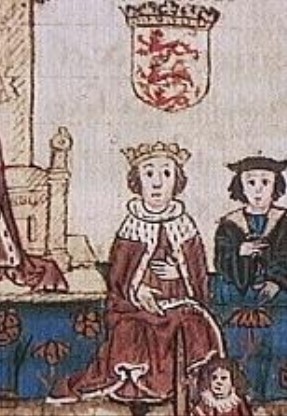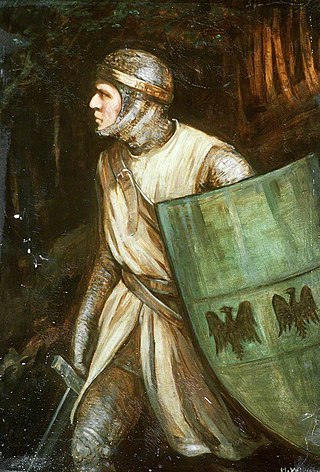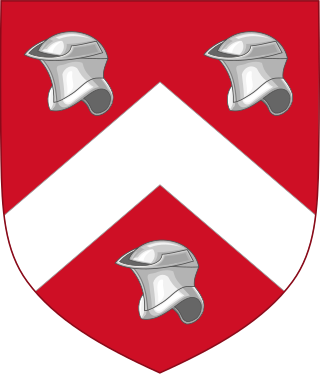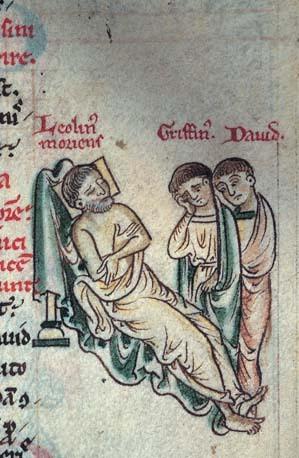
Llywelyn ap Gruffudd, sometimes written as Llywelyn ap Gruffydd, also known as Llywelyn the Last, was the native Prince of Wales from 1258 until his death at Cilmeri in 1282. Llywelyn was the son of Gruffydd ap Llywelyn Fawr and grandson of Llywelyn the Great, and he was one of the last native and independent princes of Wales before its conquest by Edward I of England and English rule in Wales that followed, until Owain Glyndŵr held the title during the Welsh Revolt of 1400–1415.

Llywelyn ab Iorwerth, also known as Llywelyn the Great, was a medieval Welsh ruler. He succeeded his uncle, Dafydd ab Owain Gwynedd, as King of Gwynedd in 1195 and became Prince of Wales in 1216. By a combination of war and diplomacy he dominated Wales for 45 years.

Owain ap Gruffudd was King of Gwynedd, North Wales, from 1137 until his death in 1170, succeeding his father Gruffudd ap Cynan. He was called Owain the Great and the first to be styled "Prince of Wales", and the "Prince of the Welsh". He is considered to be the most successful of all the North Welsh princes prior to his grandson, Llywelyn the Great. He became known as Owain Gwynedd to distinguish him from the contemporary king of Powys Wenwynwyn, Owain ap Gruffydd ap Maredudd, who became known as Owain Cyfeiliog.

Sharon Kay Penman was an American historical novelist, published in the UK as Sharon Penman. She was best known for the Welsh Princes trilogy and the Plantagenet series. In addition, she wrote four medieval mysteries, the first of which, The Queen's Man, was a finalist in 1996 for the Best First Mystery Edgar Award.

Sir Owen Tudor was a Welsh courtier and the second husband of Queen Catherine of Valois (1401–1437), widow of King Henry V of England. He was the grandfather of Henry VII, founder of the Tudor dynasty.

William de Braose was the son of Reginald de Braose by his first wife, Grecia Briwere. He was an ill-fated member of the House of Braose, a powerful and long-lived dynasty of Marcher Lords.

The Kingdom of Gwynedd was a Welsh kingdom and a Roman Empire successor state that emerged in sub-Roman Britain in the 5th century during the Anglo-Saxon settlement of Britain.

Abergwyngregyn is a village and community of historical note in Gwynedd, a county and principal area in Wales. Under its historic name of Aber Garth Celyn it was the seat of Llywelyn ap Gruffudd. It lies in the historic county of Caernarfonshire.
Ednyfed Fychan, full name Ednyfed Fychan ap Cynwrig, was a Welsh warrior who became Seneschal to the Kingdom of Gwynedd in Northern Wales, serving Llywelyn the Great and his son Dafydd ap Llywelyn. Ednyfed claimed descent from Marchudd ap Cynan, Lord of Rhos, 'protector' of Rhodri Mawr, King of Gwynedd. He was the ancestor of Owen Tudor and thereby of the Tudor dynasty.
Llywelyn, Llewelyn or Llewellyn is a name of Welsh language origins. See Llywelyn (name) for the name's etymology, history and other details.

Joan, Lady of Wales and Lady of Snowdon, also known by her Welsh name often written as Siwan was the illegitimate daughter of King John of England, and was the wife of Llywelyn the Great, Prince of Wales, effective ruler of all of Wales. Joan or Siwan in Welsh has been referred to as both "Lady of Wales" and "Princess of Wales".

The Royal House of Dinefwr was a cadet branch of the Royal House of Gwynedd, founded by King Cadell ap Rhodri, son of Rhodri the Great. Their ancestor, Cunedda Wledig, born in late Roman Britain, was a Sub-Roman warlord who founded the Kingdom of Gwynedd during the 5th century, following the Anglo-Saxon settlement of Britain. As Celtic Britons, the House of Dinefwr was ruling before the Norman conquest, having to fight with their neighbors such as the Celtics, Anglo-Saxons and Vikings, before struggling with the Normans afterwards. Many members of this family were influential in Welsh history, such as Hywel Dda, who codified Welsh law under his rule, and achieved the important title of King of the Britons, or Lord Rhys, Prince of Wales, who rebelled against Richard the Lionheart, and became one of the most powerful Welsh leaders of the Middle ages.
This article is about the particular significance of the century 1201–1300 to Wales and its people.
The Penmachno Document was a letters patent drawn up at Penmachno in Gwynedd and signed on 19 December 1294 by Madog ap Llywelyn at the height of his revolt against English rule in Wales. Though unremarkable in its content – the document consists of the grant of two parcels of land to a minor noble named Bleddyn Fychan – its importance lies in the fact that it is the only surviving document issued by Madog in which he styles himself prince of Wales as well as lord of Snowdonia.
Gruffudd Fychan could refer to:

Dafydd ap Llywelyn was Prince of Gwynedd from 1240 to 1246. He was the first ruler in Wales to claim the title Prince of Wales.

The Reckoning is a medieval historical novel written by Sharon Kay Penman published in 1991. The plot is of Wales's Llewelyn ap Gruffydd's fight to keep Wales independent of England and of the love story between the Welsh Prince and Eleanor de Montfort. In her writing, Penman presents the nobility of the period and focuses on conflict on various levels from individual conflicts to wars between countries. The novel received generally good reviews.
Fychan is a surname. Notable people with the surname include:
Tudur Hen or Tudur ap Goronwy was a Welsh aristocrat and original founder of the House of Tudor. He was one of three sons of Goronwy ab Ednyfed who received lands from King Edward I of England. Nonetheless, he backed the rebellion of Madog ap Llywelyn, but afterwards swore allegiance to both Edward I and his son, Edward of Caernarfon. Tudur Hen was responsible for the restoration of the Franciscan friary at Bangor, where his body was later placed on 11 October 1311.
Goronwy ab Ednyfed was seneschal to Llywelyn ap Gruffudd, king of Gwynedd. Goronwy was the founder of the Tudor family of Penmynydd.











